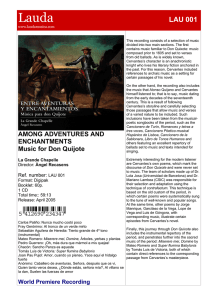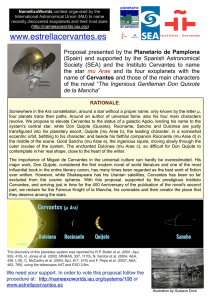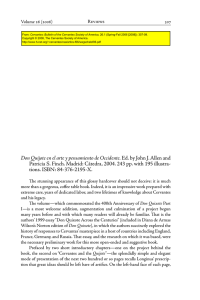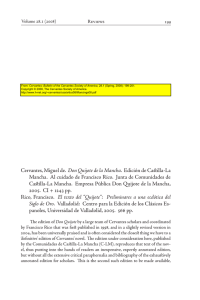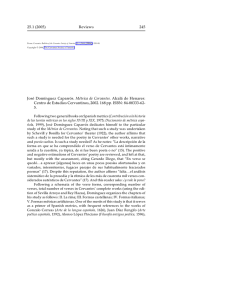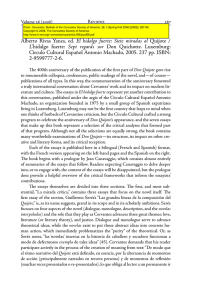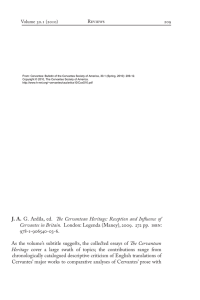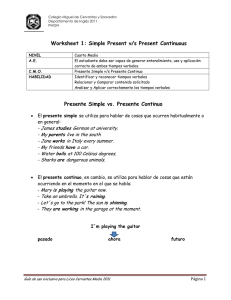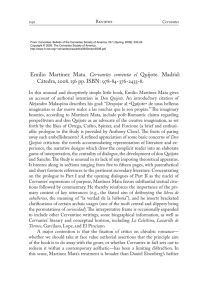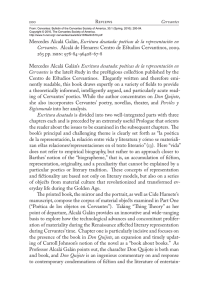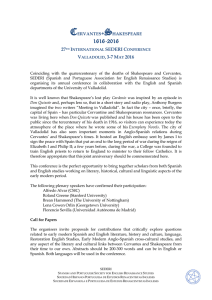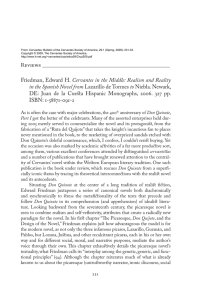Don Quijote I, 43 - H-Net
Anuncio
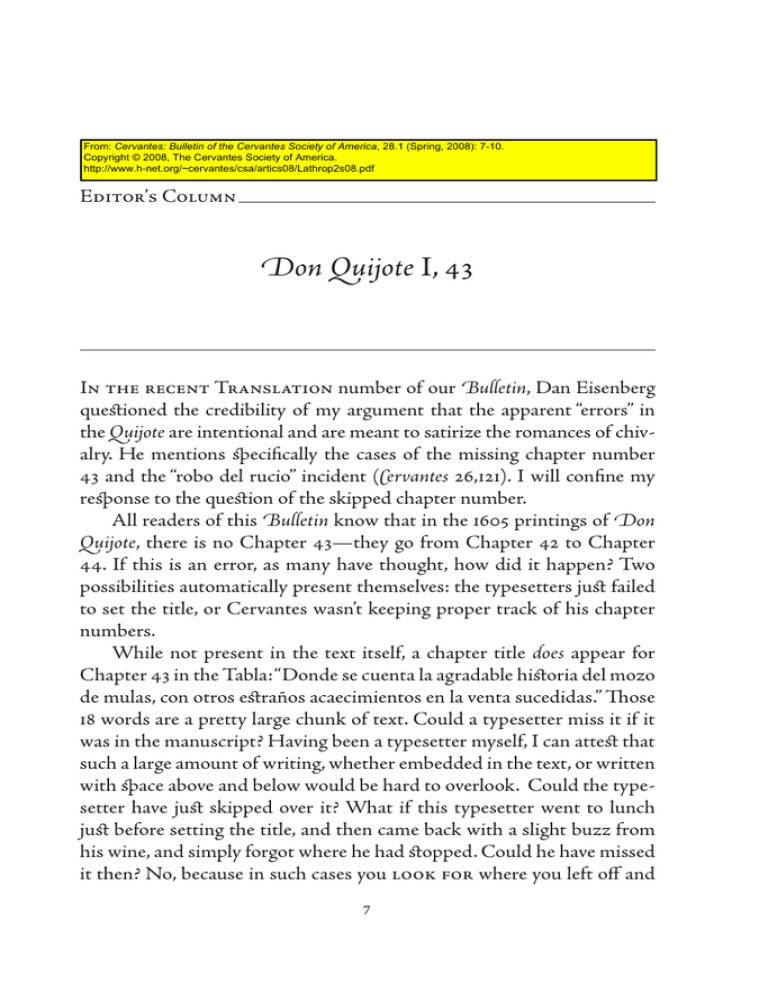
From: Cervantes: Bulletin of the Cervantes Society of America, 28.1 (Spring, 2008): 7-10. Copyright © 2008, The Cervantes Society of America. http://www.h-net.org/~cervantes/csa/artics08/Lathrop2s08.pdf Editor’s Column Don Quijote I, 43 In the recent Translation number of our Bulletin, Dan Eisenberg questioned the credibility of my argument that the apparent “errors” in the Quijote are intentional and are meant to satirize the romances of chivalry. He mentions specifically the cases of the missing chapter number 43 and the “robo del rucio” incident (Cervantes 26,121). I will confine my response to the question of the skipped chapter number. All readers of this Bulletin know that in the 1605 printings of Don Quijote, there is no Chapter 43—they go from Chapter 42 to Chapter 44. If this is an error, as many have thought, how did it happen? Two possibilities automatically present themselves: the typesetters just failed to set the title, or Cervantes wasn’t keeping proper track of his chapter numbers. While not present in the text itself, a chapter title does appear for Chapter 43 in the Tabla: “Donde se cuenta la agradable historia del mozo de mulas, con otros estraños acaecimientos en la venta sucedidas.” Those 18 words are a pretty large chunk of text. Could a typesetter miss it if it was in the manuscript? Having been a typesetter myself, I can attest that such a large amount of writing, whether embedded in the text, or written with space above and below would be hard to overlook. Could the typesetter have just skipped over it? What if this typesetter went to lunch just before setting the title, and then came back with a slight buzz from his wine, and simply forgot where he had stopped. Could he have missed it then? No, because in such cases you look for where you left off and 7 8 Tom Lathrop Cervantes start from there. But what if there is something similar to what you are looking for, but on a different line, and you start from the wrong place without realizing it? While working with two medieval manuscripts a long time ago, one being a copy of the other, I saw that the copyist must have gotten distracted, but knew that his next line began with era. Four lines below in the manuscript he was copying, there was another line that also began with era, and that is where the copyist mistakenly picked up his work. But what about this text? Is there anything in this text remotely similar to what is in the chapter title that could have confused the compositor? Decidedly not. What is the only logical conclusion? There must have been no title numbered 43 in Cervantes’ manuscript. Why would that have been? In the Prologue to Don Quijote I, the author’s helpful friend winds up his advice by telling him: “You only have to imitate the style of what you’re writing—the more perfect the imitation is, the better your writing will be.” This is exactly what Cervantes does. He satirizes not only the characters and situations of books of chivalry, but also their style of writing, complete with errors and contradictions. They are built into his novel on all levels. They are intentional and are meant to be left alone. But editors, including the Royal Academy of the Language, “correct” the book, much of the time without annotating their changes. One example of this satire is in the “mistaken and careless” chapter titles. In El Caballero del Cisne, chapter 114 is announced this way: “Cómo sus enemigos mataron el caballo del caballero del Cisne,” but the horse was killed in a later chapter. Cervantes imitates that type of real error in the chapter title of Don Quijote I,10, which reads: “De lo que más le avino a don Quijote con el vizcaíno y del peligro en que se vio con una turba de yangüeses.” The episode with the Basque is clearly over, and the Yangüeses don’t appear until five chapters later. What fun! Cervantes is satirizing the type of erroneous chapter title just seen in El Caballero del Cisne. But the Royal Academy of the Language in its 1780 edition of the novel, clearly not realizing that it was satyrical, decided to help Cervantes out by “fixing” the “mistaken” chapter titles. The Academy changes this Volume 28.1 (2008) Editor’s Column 9 title to: “De los graciosos razonamientos que pasaron entre Don Quijote y Sancho Panza, su escudero.” The second example of misinformation about the contents of a chapter is in Part I, Chapter 36, where the title reads: “Que trata de la brava y descomunal batalla que don Quijote tuvo con unos cueros de vino tinto, con otros raros sucesos que en la venta le sucedieron.” The “descomunal batalla” has already taken place, and everybody knows it, especially Cervantes. These contradictions are not subtle. But once again, the Academy rescues Cervantes from another perceived gaffe by changing it to: “Que trata de otros raros sucesos que en la venta sucedieron.” The very next chapter title shows a false start: “Que trata donde se prosigue la historia de la famosa infanta Micomicona, con otras graciosas aventuras,” where “Que trata” is the false start and creates a grammatically erroneous sentence. Would Cervantes have committed such a faux-pas? No. I contend that he would not—that he is just having fun. Once again the Royal Academy misses the satire and once again fixes it. The title for Chapter 45 bears the Roman numeral XXXV, thirty five. This can hardly be a typesetter’s mistake since it is so different from the “correct” XLV. It has to be that Cervantes “made a mistake” on purpose again. But the Academy and other editors correct it to XLV. Part two, Chapter 37, is identified with the Arabic number 37—the only Arabic chapter number in the book. The Academy saw just another incongruity here, and fixed it by changing it to XXXVII. No need to annotate the change—it’s just another bit of carelessness, right? Another thing Cervantes did was to use the same chapter number for two successive chapters—Part II, Chapter VII is identified with VI. Are the typesetters going to make a mistake with chapter numbers? It is unlikely. I know from experience in my typesetting days that you pay special attention to numbers. Again editors correct this to VII. This change is rarely noted—the “error” seems too obvious. Let’s see, Cervantes has given misinformation in his chapter titles (I,10 and I,36), he has used a false start (I,37), he has switched a couple of titles around (I,29 and I,30), and he has misnumbered three chapters in three different ways (XXXV for XLV, and 37 for XXXVII, and VI for VII). What other variant can he use? He can skip a number! (I,43). 10 Tom Lathrop Cervantes At the outset of this note, I suggested two possibilities for why there was no Chapter 43. But the third possibility is that Cervantes skipped it on purpose. Had the Academy, and other editors since, allower the “errors” and “contradictions” to stand, we readers could see the whole range of Cervantes’ satire. In “correcting” them, they have eliminated a level of the book’s satire and deprived us of its enjoyment. Mozart once wrote what he calls “Ein musikalischer Spaß” (“A Musical Joke”). Everything about it is bad or wrong: the theme is corny, all the rules of composition are broken, chords do not resolve. Listeners of the time, hearing something so amusingly different from what Mozart—the master of exquiste taste—normally did, would have laughed out loud. They would have realized Mozart was satirizing the bad music of the time and was having fun doing it. Mozart didn’t need to announce his satire. But maybe, in retrospect, Cervantes should have. In his Prologue, instead of subtly preparing his readers for the satire by saying only that a friend had advised him to imitate the style of the books of chivalry, maybe he should have said: “Those romances I am imitating used a slipshod style and had some errors and contradictions, and you’ll find all of that in my book, too.” By doing that, he would have protected the integrity of that level of his book’s satire. Who knows? Maybe then even Clemencín would have been friendly. But Cervantes’ contemporary readers, like Mozart’s listeners, needed no such explanation. Modern editors, by calling every satyric inconsistency a “notoria equivocación,” “lapsus o error,” “descuido de Cervantes,” “claro error,” simply poison the minds of readers. How ludicrous it would be to chide Mozart for his “Ein musikalischer Spaß”! And how ludicrous it is to rebuke Cervantes for is his rather lengthy “literarischer Spaß”!
